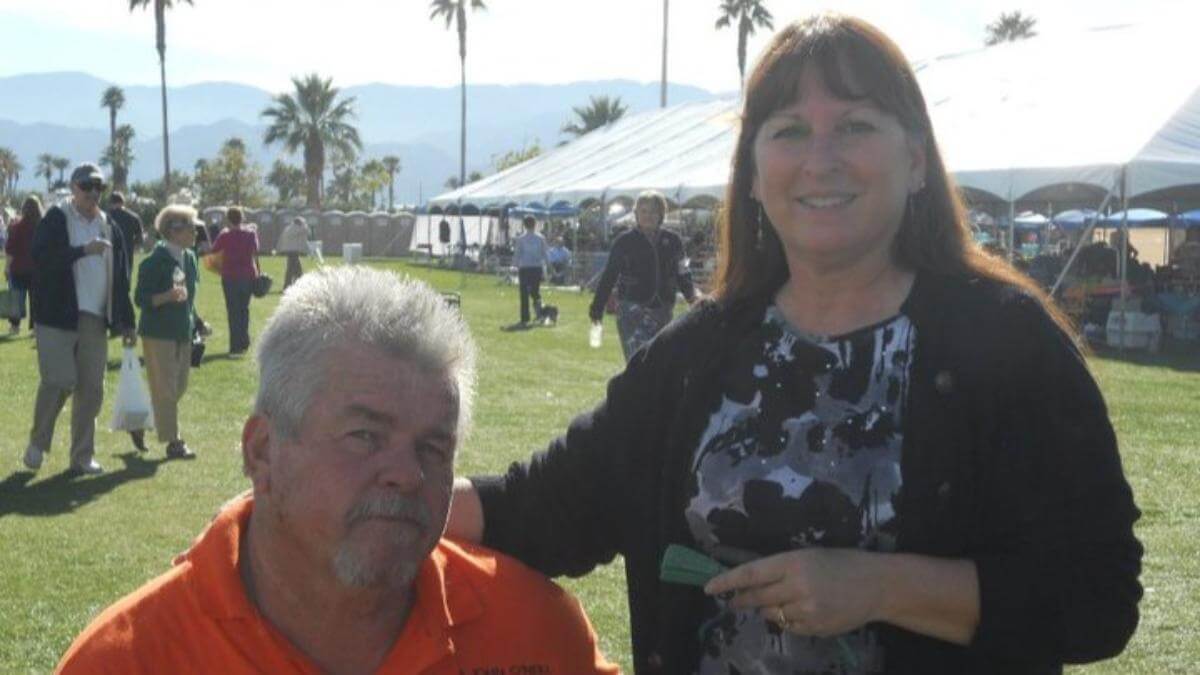
Home » John & Claire O’Neill | Bark Bark Samoyeds

John & Claire O’Neill
1. We live in Northern Arizona on 2-1/2 acres where our dogs have lots of room to run, play, and be vocal. We have owned Samoyeds going back to the mid-1980s, and have been showing them since 2008 when we purchased our first show dog who became a top-winning Multi. Best in Show dog. We had our first litter of nine puppies at the end of 2011. Our kennel name is Bark Bark Samoyeds.
2. Temperament. This dog is a pack animal and needs to be able to get along with other dogs to work. Originally from Siberia, they were used to help herd reindeer, pull sleds, keep the family warm, and help protect the children. They are a wonderful breed to have around children and they get along well with other breeds.
The Sammy Smile is certainly a hallmark. Not just important because we all love to see that smile, but also, in the cold weather, droopy flews can be dangerous, collecting ice. Their smile features black-rimmed lips and a slight upward curve at the corners.
Expression. A combination of correct eye set and color, ear carriage and placement, and those upturned corners of the lips give that beautiful alert look.
Ears. They need to be thick and well feathered. Set well apart and rounded. Not too long. Large ears would freeze in the elements. The ear, when bent down, should reach the outer edge of the eye, and not go further.
Dark-rimmed, almond-shaped eyes reduce the risk of snow blindness and flying ice and snow. Round eyes are incorrect.
Coat. They are double coated. The undercoat is short, dense, and soft. The outer coat is long, straight, and coarse, and it should stand off and be weather resistant. Quality of coat is more important than quantity. Droopy coats don’t do well in the elements.
3. Absolutely, there are enough homes to warrant a litter. As a breeder, it is important to maintain a website or Facebook page where the public can find you, see what you are breeding, and how your dogs are raised and cared for. If you have a good reputation as a breeder of healthy, well-socialized puppies, and keep in touch with your puppy families, it is much easier to find homes.
We have placed dogs in eight homes that have come back to us for a second or third puppy, or taken a few of our retired dogs to live with them.
4. Yes, we have successfully used semen collection and freezing in our breeding program. Four litters using frozen semen from dogs that are no longer with us resulted in a total of 17 puppies. And now, with in-house progesterone available, we have been very successful in breeding our girls at the right time, no longer having to wait a day or more for the numbers.
Genetic testing is very helpful now, especially since there are some undisclosed health issues going back generations. The Orthopedic Foundation for Animals (OFA) has expanded to include many new health tests beyond their initial testing for hip dysplasia. And there are numerous online videos and podcasts regarding canine reproduction and health for your brood bitch and stud dog.
5. Somewhat, but so much more needs to be done. The mixing of breeds for those “designer” dogs has to stop and the public needs to understand that when this is done, you double the health issues. And they are paying much more for them than what a lot of breeders charge for health-cleared, purebred dogs.
I like that the Westminster Kennel Club is getting more attention from the public. It would be nice if they could find a way to make all the Breed judging accessible to the public so that people can learn more about all of the breeds.
The public also needs to know that responsible purebred breeders will always take back anything they have bred, if someone doesn’t want, or can no longer care for, their dog. The reason there are dogs in pounds and rescues is because they were not from a responsible dog breeder.
6. It is nice to be able to get results quickly online with most superintendents now. You don’t have to wait for the cluster to be over and wait for results to get processed. It is easier and faster to see where you are in points than waiting for monthly totals to be posted.
One thing we are concerned about in our breed, on the West Coast, is that the number of class dogs and bitches being placed in show homes has declined greatly. In Southern California, you can get majors at the beginning of the year at the Palm Springs show and after that you need to travel for them. It wasn’t like this five-plus years ago.
7. Some positive things happening in the sport have been more clubs adding Fast CAT, Barn Hunt, and Dock Diving. They are also having Pee Wee events. We happen to have a newer owner handler who has a five-year-old who is doing an amazing job in the Pee Wee ring. We look for her to be a great Junior Handler. We also like that the National Owner-Handled Series (NOHS) is getting more recognition. Four Bark Bark dogs are being shown in Owner-Handled this year.